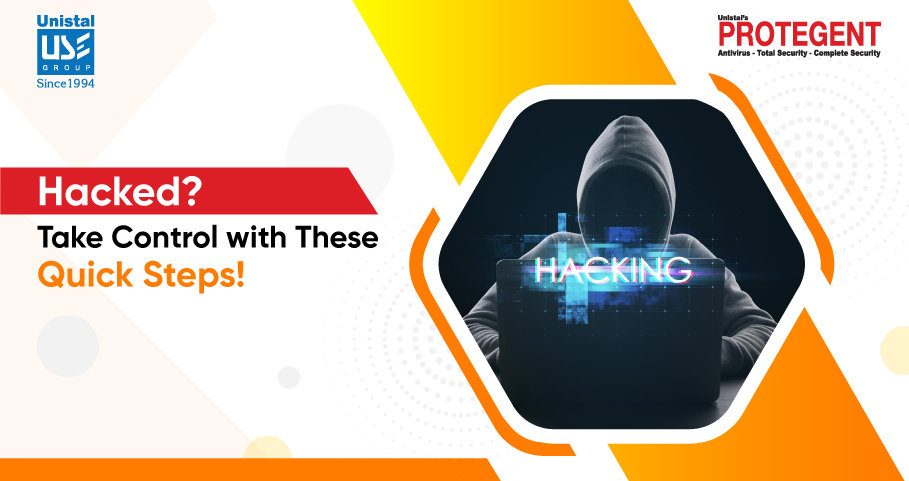
Is someone attempting to hack you online? A Quick Guide to Safeguarding your Data
In the digital age, the threat of hacking and cyberattacks has been ever-present. Whether you’ve inadvertently engaged with scammers or encountered a phishing site, knowing how to respond is crucial.
How can you guard against hacking?
Here’s a comprehensive guide on what steps to take if you suspect someone is attempting to hack you:
Don’t provide any further details
The first and most important guideline that you can immediately put into practice is this one. Close the website right away if you have any uneasy feelings about it after being asked for your name, email, phone number, or bank card information.
Hang up the phone right away and don’t answer if the person calls back if you are having an unusual chat with someone over the phone, even if they seem to be from your bank or tech support. Complex schemes are a common tool used by scammers; they might contact you over instant messaging or phone from a different number while posing as someone else or an official from a different company. Shut them out.
Close the program and end the conference if you’re using a video conferencing solution like Zoom.
Unplug your gadget from the internet
This is a crucial step if someone has used remote control software, such as Zoom, Skype, Microsoft Teams, or Google Meet, to perform an action on your computer or if you have installed any apps at their request. If this is the case, there’s a good chance that your computer or smartphone has malware on it. Turning off cellular data and Wi-Fi will instantly isolate your computer or phone from the internet, preventing the thieves from remotely managing it. Turning on Airplane Mode on your phone or unplugging the Ethernet connection if your PC is linked to the internet via one is the easiest and quickest way to accomplish this.
Consider what information the hackers may have obtained
Try to recall whatever information you gave the caller or typed on the website if you have ever visited a dubious website. Name and address? Phone Number? The number on a bank card? Any password?
You don’t need to do anything more if you only give your name, address, and phone number. However, be cautious since the con artists may probably try to use your information to launch another hoax in the future.
If you have disclosed additional private information—passwords, images of personal papers, bank account details, etc.—the situation is more dire; in this instance, heed the guidance in the next two sections.
Modify your usernames
Replace the hacked password with a fresh one that is specific to each service and quickly log in to all of them. If you unplug your gadget from the internet, use a different one instead of plugging in the possibly contaminated one. If you don’t have another device, don’t be afraid to approach your neighbors or coworkers for assistance. Here, time is of the essence; every minute matters. Instead of clicking on links in recent emails, manually input the website URL or open it using your browser’s bookmarks when visiting any services.
Changing the password alone won’t work if the one you typed was for a payment system, an online banking platform, or any account that holds money. Instead, complete the following actions.
Get in touch with your service provider – bank, or credit bureau
Get in touch with the bank right away if you have provided bank card numbers or other financial details. In most cases, blocking cards may be done using a special hotline, the mobile app, and your individual online account. For other data categories, such as bank account information, speak with experts at the bank or online provider about appropriate security precautions. Call the number provided on the bank’s website or mobile application instead of waiting for a call from the bank, as they could be con artists.
Malicious actors may exploit your shared images of papers or comprehensive personal information fraudulently, for example, to apply for loans. Contact the credit bureau to find out what safeguards measures are available for you so that this doesn’t happen. Generally speaking, these measures involve blocking new inquiries, self-banning credit issuance (i.e., making it impossible to get a loan in your name), and setting up notifications for any inquiries about your credit history.
Examine your system
If you took our advice and unplugged your computer from the internet because you thought it could be infected, make sure it is free of malware and other potentially dangerous applications before connecting it to the network again. And ensure you are using Antivirus Software to add a protective layer to your online world. If you already have a Total Security program installed, like Kaspersky, Protegent, or Quick Heal, make sure that all scanning and protection technologies are turned on and that the protection databases have been updated lately before doing a thorough scan. It’s important to do the most thorough scan possible, using settings that can identify potentially hazardous applications like remote control tools in addition to viruses. Using Antivirus Software can be helpful as it scans and deletes any malware that has been found in accordance with the security application’s recommendations.
Look for any questionable behavior
Verify that the attackers haven’t been able to use the possibly compromised accounts for any malicious purposes after completing all the actions outlined above. Check your most recent purchases if these are bank accounts or Internet stores. Try to cancel any purchases you didn’t make by getting in touch with the bank or online retailer.
Check out new friends, recent posts, picture album material, and other stuff on social media. Verify your most recent conversations in messaging applications to be sure no phony messages were sent using your account.
Verify your name, contact details, address, profile picture, and payment information for each account. Change your password and, if you can, protect the account with two-factor authentication if you detect any changes, as this indicates that the account has been hacked.
Make sure you review the details on the devices that are connected to your social media, messaging, and internet service accounts. Once an account has been compromised, hackers attempt to keep access to it by, for example, connecting their device to it. This connection may continue even after you change your password, depending on the provider. As a result, it’s imperative that you identify every device and open session that is shown in the “Security” area (depending on the particular service, this section may also be referred to as “Devices,” “Connected devices,” “Recent sessions,” and so on). You may normally kick out outsiders by using the “Disconnect device” or “End session” buttons that are usually located next to the name of the connected device.
Make sure you remember your changed password before disconnecting any devices and/or sessions that are specified. The attackers can no longer access your accounts, but you will need to log in using the new password (you did change it, didn’t you?).
The aftermath of an email breach is the most difficult thing to handle. In addition to everything mentioned above, you must first review the mail forwarding policies. Verify that sending emails to third-party addresses is not enabled in either your message processing rules or mailbox settings. Second, most service accounts that are connected to your email can be hacked by criminals. Change the password on any services connected to that email address and keep an eye out for any unusual behavior if you discover any indications that your email has been compromised.
Prevention is better than cure
It takes a great deal of time, patience, and work to follow the following suggestions. It is crucial to take preventative action ahead of time in order to reduce the likelihood of fraud as much as feasible.
Defend your smartphone from loss or theft.
For each account, use a different password and two-factor authentication. You may generate fresh, one-of-a-kind passwords and save them together with the authentication tokens with the use of a password organizer that has an authenticator built in.
Set up a thorough security system on every computer and mobile device you own. This will stop the majority of fraudulent and phishing emails and links.
To Sum up
Remember that the best way to lessen the effects of hacking efforts is to take preventive steps and respond quickly. You can preserve a safe online presence and safeguard your digital identity by being watchful, acting quickly, and using antivirus software for advanced protection.




